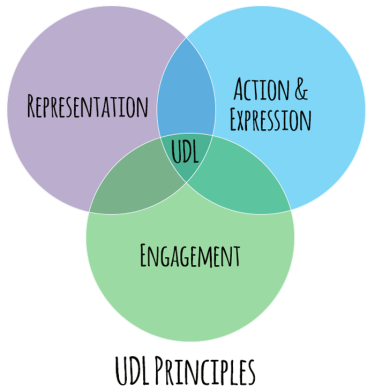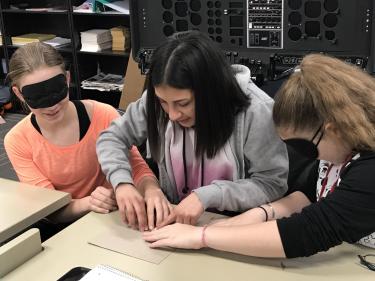Inclusive and Universal Design
What is Universal Design?
Universal Design for Learning (UDL) is a model that emphasizes three core areas:

Engagement, Representation, and Action & Expression. These areas can be applied to any subject and help to create meaningful and challenging learning experiences that meet the individual needs of all students.
- Engagement - focuses on Why students choose to learn and how to foster purposeful, motivated learners, stimulate interest and motivation for learning
- Representation - focuses on What studens choose to learn and how to support resourceful, knowledgeable learners, present information and content in different ways.
- Action & Expression - focuses on How students learn and how to develop skills for strategic, goal-directed learners, differentiate the ways that students can express what they know.
Learn more about Universal Design:
- CAST website - Center for Applied Special Technology - provides an overview and guidelines for Universal Design for Learning (UDL)
- Universal Design Learning Guidelines - CAST website
- Universal Design Guidelines for Public Programs in Science Museums from the NISE Network
What is Inclusive Design?

Inclusive Design is a key design principle for our work. It means designing to INCLUDE learners with diverse needs and interests as both users and producers. It extends universal design for learning (UDL) principles (Meyer, Rose & Gordon, 2014), which focus on designing to maximize learning by offering individuals multiple means of engagement, representation, and expression. Inclusive Design extends UDL in its emphasis on developing empathy and perspective-taking for the end-user, or audience(s) and its emphasis on the importance of including end-users as designers and producers.
The Build a Better Book project applies UDL principles through its workshops that support youth in designing tactile books and games for children who are visually impaired. We offer youth multiple opportunities for engagement through participation in a collaborative service-oriented project that is interest-driven, has an authentic audience, offers choice of topic, tools, and methods, and includes ongoing sharing and reflection. We also design workshops to include multiple means of representation and expression as youth learn about tactile design and use digital tools and materials to create their products with support from workshop facilitators and youth mentors. Throughout the project, participants develop empathy and perspective-taking as they engage in sensory activities, view videos, and interact (in person or virtually) with individuals who are blind. Although end-users often provide feedback on designs, we are actively working with organizations and individuals in the Blind community to offer Build a Better Book workshops and partnerships where individuals are designers and producers.
For our team, Inclusive Design is a matter of equity and justice. It also just makes design sense.
Universal Design Videos
Watch these videos for a fuller explanation of Universal Design concepts:
UDL at a Glance:
Meet the Normals- Adventures in Universal Design:
Why We Need Universal Design - Michael Nesmith, TEDx Presentation:

